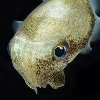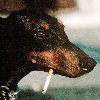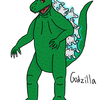HOME | DD
 TrollMans — Slayer Carnackle
TrollMans — Slayer Carnackle

Published: 2022-10-06 06:42:06 +0000 UTC; Views: 27671; Favourites: 465; Downloads: 28
Redirect to original
Description
During the desolate age of the Mid Ultimocene, when life scraped by in the throes of a bitter global ice age, the trunkos achieved great success due to their adaptability and generalist lifestyle; all species could consume both animal and plant matter to varying degrees, allowing them to better scrape by in hostile conditions when food was scarce. However, these times are now long behind them, and in a new world of plenty, many trunkos are now diverging into much more specialized paths to exploit these new resources. Although it may not be sufficient in the longterm, natural selection has driven numerous lineages to take advantage of new niches, with numerous species now diverging into more specialized and efficient herbivores and carnivores, and now numerous species exist which consume almost entirely either plant or meat. This includes the first truly predatory trunkos, hypercarnivores acutely adapted to hunt and kill large prey.
With grazers and browsers now immensely plentiful across the endless grasslands, bogs, and prairies of the northern continent, an equally diverse menagerie of predators have developed to exploit this bumper crop. The ever successful trunkos are unsurprisingly among them, and it was the aggressive and boorish carnackles which has first developed into specialized macropredators. The fang-like hooks that lined the underside of the trunk-like facial tentacle have developed into flattened, blade-like projections reinforced with keratinous plates embedded into the skin that allow them to cut through hide and flesh much more easily. Those on the bottom jaw and those on the top jaw rub against one another when closed and opened to keep them honed to a sharpened edge. The shortcoming of the carnackles’ facial maw is that is comprised almost entirely of muscle and has trouble applying great force while biting down; the beak itself is wide and blunt, making it more than capable of crushing bone when feeding, but, buried deep within the facial tissue, it is an ineffective hunting weapon. This makes killing prey via suffocation or breaking through bones more difficult, so the slayer carnackles have evolved to dispatch prey through exsanguination.
An extraordinarily muscular neck allows the carnackles to make powerful blows with their head, cutting deep into the flesh with each strike, like a butcher's cleaver. It targets the softer and more fleshy body regions, such as the throat, the flanks, or the thighs, aiming to cause catastrophic injury, either killing within minutes through shock and blood loss, or trailing an injured target for days as it weakens from its wounds. In this buggy and moist environment, even a seemingly superficial injury can often prove fatal from secondary infection, a possibility made far more likely when continuously stressed as it is doggedly shadowed and harassed by the hungering carnackles, giving it no chance to rest and recuperate. The slayers generally avoid hunting the more heavily armoured and often disease-ridden thorngrazers when possible, and the mainstay of their diet usually consists of other trunkos, primarily snoots and wumpos, although grazing skuorc descendants such as the scrunges and skoblins are also occasional targets, as are some seraph species, if they can catch them while they’re grounded. Although some faster wumpos and snoots can outpace them over shorter distances, hunting together, the carnackles can gradually wear down and tire their prey by chasing over their quarry over several miles, with the slayers switching between runners to keep up the pace.
The carnackles generally live in pairs, usually same-sex sibling pairs or mated pairs. Hunting large animals relies on the success of a pair’s cooperation; animals with no partner (most commonly a newly independent subadult with no siblings who has not yet found a mate) tend to focus on smaller prey like poppits or snifflers or try and mooch off of other slayer carnackles. Carnackles are tolerant of one another and will often willingly share a kill, making aggregations of several unrelated slayers on a carcass not uncommon; there is often more meat on a kill than two slayers can eat in one sitting and no way to store food for later; better it be that others of their own kind eat the rest than a competing predator species. Pairs will always have two eggs per clutch, one for each parent to hold in their pouch. The first to hatch gets priority by its parents, with the second primarily serving as a contingency; if hunting is good, both chicks will be fed equally, but if not, the larger chick will get the bulk of the feeding to increase the chance at least one survives rather than none. Although chicks are capable of walking only hours after hatching, it can take up to a year for them grow strong enough and gain the skills to hunt on their own, and another year for them to become fully independent. Slayer carnackles which grow up with a sibling tend to become independent earlier because of the greater socialization skills they gain earlier in life.
Adults generally reach around six to seven feet in height and approach one-hundred and sixty kilograms in weight, with females on average being slightly larger than males, but otherwise having little sexual dimorphism; this makes the slayers one of the largest land predators of Serinarcta. It often takes the better part of a decade for the carnackles to reach sexual maturity, but most that do usually have a long and successful life ahead of them; with few natural predators once full-grown and herds of prey roaming in the lands in their countless millions, adults can often live into their twenties, or even into the early forties in exceptional cases; an phenomenal age for a predator, especially in an ecosystem as competitive as this.
Related content
Comments: 38

👍: 0 ⏩: 0

👍: 0 ⏩: 0

👍: 0 ⏩: 0

👍: 0 ⏩: 0

👍: 3 ⏩: 0

👍: 3 ⏩: 0

👍: 2 ⏩: 1

👍: 0 ⏩: 1

👍: 0 ⏩: 1

👍: 0 ⏩: 0

👍: 2 ⏩: 1

👍: 0 ⏩: 0

👍: 1 ⏩: 0

👍: 0 ⏩: 0

👍: 0 ⏩: 0

👍: 0 ⏩: 0

👍: 1 ⏩: 0

👍: 0 ⏩: 0

👍: 1 ⏩: 0

👍: 1 ⏩: 0

👍: 2 ⏩: 1

👍: 0 ⏩: 0

👍: 2 ⏩: 0

👍: 2 ⏩: 0

👍: 2 ⏩: 0

👍: 1 ⏩: 2

👍: 1 ⏩: 1

👍: 3 ⏩: 1

👍: 1 ⏩: 1

👍: 1 ⏩: 0

👍: 0 ⏩: 0

👍: 3 ⏩: 1

👍: 1 ⏩: 1

👍: 1 ⏩: 0

👍: 1 ⏩: 0

👍: 3 ⏩: 0

👍: 2 ⏩: 0

















